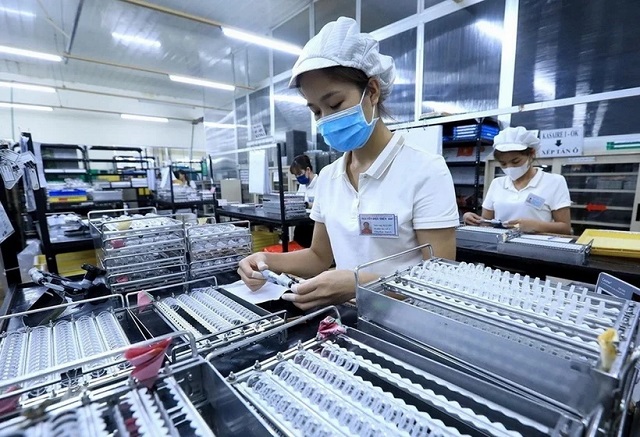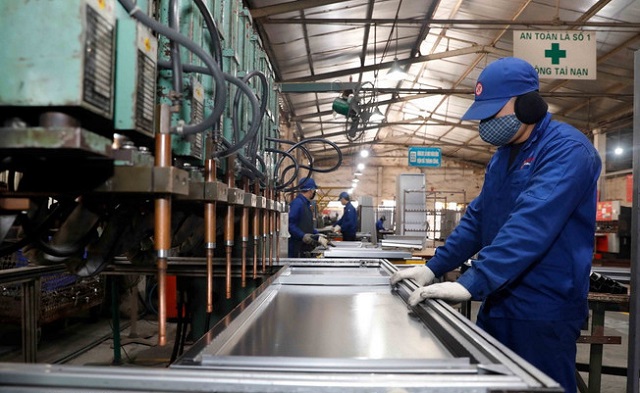
|
Factory workers at an FDI-invested company. (Photo: Tuan Anh/VNA)
|
The merger of provinces and cities will not only facilitate the development of infrastructure and utilities but also boost investment in the coming time.
Especially, important administrative reforms are expected to unlock resources and remove bottlenecks for the private sector, thus reinforcing investors’ confidence.
As of today, July 1, 2025, the local government apparatus at two levels in 34 provinces and cities will officially operate.
Earlier, on June 30, a ceremony was held nationwide to announce the National Assembly’s resolution on the merger of provinces and cities, along with the Central Party Committee’s decisions on the establishment of Party committees and local leadership.
According to General Secretary To Lam, the decision to “rearrange the territory” is a historical step with strategic significance, marking a new stage in the development of perfecting the state administrative apparatus, and perfecting the system and organization of the political system. It aims for a modern, streamlined, and effective governance system that is close to and serves the people, so that all benefits belong to them.
General Secretary To Lam also emphasized that reorganizing the administrative boundaries and operating a new local government model is an objective and inevitable requirement for the country’s development in the context of globalization, digital transformation, and the Fourth Industrial Revolution.
The rearrangement of administrative units will not only bring a new face to the local government system but also open up a vast and promising development space for each region, locality, and the whole country.
Analysts compare this reform to “Renewal 2.0” after the economic renewal in 1986. This event is expected to not only create new growth momentum for Vietnam but also help maintain a stable credit outlook amid prolonged global instability.
Experts from VCBS (Vietcombank Securities Company) assessed that the merger of provinces and cities would result in larger scales in terms of area, population, and economy, facilitating infrastructure and utility development.
For example, after merging with Binh Duong and Ba Ria-Vung Tau, Ho Chi Minh City becomes a “super metropolis” in the ASEAN region and has the largest economic scale in Vietnam, with an area of over 6,700 km2, a population of nearly 14 million people, and a GRDP of more than 2.7 million billion VND.
The new provinces and cities not only expand in scale but also integrate different types of terrain and development advantages. Ho Chi Minh City (new) will possess a comprehensive economic strength, including urban economics (old Ho Chi Minh City), industry and FDI (Binh Duong), and port services, logistics, and tourism (Ba Ria-Vung Tau).
In addition, the combination of regional characteristics such as sea, plain, and mountainous areas also helps provinces strengthen comprehensive socio-economic links. The merger of Ha Nam, Nam Dinh, and Ninh Binh will form a large economic pole in the North, with industry, tourism, and urban development as its pillars.
Similarly, the integration of Da Nang and Quang Nam will expand the development space for Da Nang’s urban and industrial-service areas, thereby promoting the special mechanism and the establishment of a Free Trade Area.
With abundant land, population, and resources, local governments can now comfortably plan economic development areas and transportation systems on a large scale, reducing the risk of non-connectivity in other localities as before. This is especially significant for large industrial projects, which often require a synchronous logistics system and convenient connections to input materials, labor, and large-scale port and airport infrastructure.
Besides, the merger of provinces and cities can significantly improve capital allocation efficiency and budget management by centralizing resources. This can overcome the previous situation where some localities were limited in terms of population scale, economy, and budget resources, making it difficult to realize their development vision due to dependence on central budget supplements.

|
Activities at the stamping workshop of Xuan Hoa Joint Stock Company, Phuc Yen city, Vinh Phuc province. (Photo: Tran Viet/VNA)
|
Mr. Michael Kokalari, Head of Macroeconomic Analysis and Market Strategy at VinaCapital, said that the ongoing restructuring of the government apparatus is part of a series of strong actions to help Vietnam escape the “middle-income trap.”
According to Mr. Michael Kokalari, these efforts focus on enhancing the value of urban areas, improving regional planning for infrastructure development, and reducing the bureaucracy of the administrative apparatus. The key to the success of this reform lies in integrating digital transformation in public services and promoting synchronous implementation.
Experts from VIS (Vietnam Credit Rating Joint Stock Company) assessed that a streamlined administrative system and supportive policies from the Government would boost infrastructure projects and sustain more robust economic growth.
According to Mr. Nguyen Dinh Duy, Director and Senior Analyst at VIS Rating, the administrative merger at the provincial level will streamline decision-making processes and improve budget allocation efficiency. At the central level, the requirement to reduce 30% of administrative procedures will also help expedite policy implementation and remove legal barriers for many economic sectors.
“Important administrative reforms being implemented, such as streamlining the government apparatus, merging provincial-level units, and simplifying administrative procedures, are helping to unlock resources and remove bottlenecks for the private sector,” said Mr. Duy.
Recently, the Politburo also issued four breakthrough resolutions signaling a strategic shift in the long term – promoting the private sector, prioritizing the development of green and high-tech industries, and strengthening legal institutions.
VIS believes that with the government’s push to increase infrastructure spending in the second half of the year, the domestic business environment will receive positive support, and the innovation process will proceed smoothly, thereby reinforcing investors’ confidence. At the same time, Vietnam’s credit outlook is expected to remain stable in the second half of 2025, thanks to proactive fiscal policies and positive institutional reforms, mitigating the impact of global instability.
Hua Chung
– 13:56 07/01/2025
Bolstering Investor Confidence in the ‘Restructuring’ Decision
The ongoing administrative reforms post-provincial mergers are expected to unleash resources, clear bottlenecks for the private sector, and boost investor confidence. These strategic initiatives are designed to streamline processes, enhance efficiency, and create a conducive environment for businesses to thrive. With a focus on removing obstacles and optimizing systems, these reforms are a testament to our commitment to fostering a dynamic and investor-friendly ecosystem.
The New Provincial and Municipal Party Secretaries: A Comprehensive List
“Unveiling the Newly Appointed Provincial and Municipal Party Committee Secretaries: A Comprehensive List of Vietnam’s Post-Merger Leadership.”
The President Speaks on a Special Milestone: Implementing a Two-Tier Government Structure, Effective Immediately.
“Today marks a significant milestone for the nation’s capital, Hanoi, and indeed the entire country. From this day forward, Vietnam will consist of just 34 provinces and cities and 3,321 wards, communes, and special districts. This is a historic moment, and we applaud the leadership and vision of President Luong Cuong, who has guided us to this pivotal point in our nation’s development.”
The Surprising Truth About Khanh Hoa: A Single 10,000-Hectare Project Accounts for 95% of the Province’s Registered Investment Capital in the First Half of the Year
With an impressive investment of over 283,000 billion VND, the Cam Lam New Urban Area project by the Vinhomes joint venture has accounted for nearly 95% of Khanh Hoa province’s total registered investment capital in the first six months.











![[Photo Essay]: Experts, Managers, and Businesses Unite to Forge a Path Towards Sustainable Green Industry](https://xe.today/wp-content/uploads/2025/07/z678592918-150x150.jpg)


![[Photo Essay]: Experts, Managers, and Businesses Unite to Forge a Path Towards Sustainable Green Industry](https://xe.today/wp-content/uploads/2025/07/z678592918-100x70.jpg)






